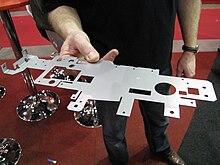Punching (process)


Punching is a cutting process for the production of flat parts from different materials ( sheet metal , cardboard, textiles, etc.) with a punch press or by hitting a cutting tool with a hammer head . In the case of metallic materials, shear cutting is usually used, in which the cutting tool consists of two parts: The base has a recess that corresponds to the shape of the punch used (with a certain tolerance). The contour of the shape to be punched out is thus notched at the same time from above and below by the cutting edges of the base and the punch and is finally sheared off. For softer materials such as leather, plastic and cardboard, the knife cut process is usually used, in which the contour to be punched is cut out by a suitably shaped blade that pushes against a solid surface.
description
A punching tool consists of the punch , which represents the inner shape, and the die, which has a suitable opening (example: punch ). Depending on the tool structure, the punch can be both the upper and the lower part of the punching tool. Depending on the application, the counterpart to the stamp can also be a flat surface. Then there is the upper tool part of a correspondingly shaped, closed punching knife (Example punch , punch , Coaster -production). The pad is made of a softer material than the knives, often referred to as the cutting line.
Periodic punching of small circular segments in a row to cut out sheet metal parts is known as nibbling . There are hand-operated nibblers, nibblers as electrical handheld devices and also CNC-controlled nibbling machines.
In high-performance stamping , processes such as welding , flanging , riveting and forming are integrated in special progressive tools. These sometimes highly complicated tools need to be used effectively and effectively protected.
The waste that arises when punching is called punching slugs .
When punching cardboard and corrugated cardboard , the punching tools contain not only the punching knives but also creasing lines so that punching and creasing (preparation of the folded edges) take place in one operation; in this case the punching base is usually provided with creasing arrangements.
The punching of non-metals was first used in the manufacture of leather goods, primarily for shoe production. Sharply ground spring steel strips were placed around a wooden core of the appropriate shape and riveted or nailed. Later cold rolled , ground and hardened carbon steel came into use. The steel was bent according to pressboard templates and then welded. Forged knives, especially for the manufacture of shoe soles, were also used for a long time.
A somewhat later - partially parallel - development is the steel strip cut , which is now often referred to as a punching form. Here, carbon steel strips (cutting lines) are bent in order to be inserted into slots in carrier plates - mostly made of wood - which are worked into by scroll saws or laser cutting (with glass fiber using a water jet cutting system ). They serve as a fixation for the cutting lines. The spaces between the cutting lines are filled with rubber material, for example, to enable the cardboard material to be ejected. An example of this is the production of cardboard packaging , beer mats, thermoforming articles and puzzle parts.
CNC punching
With CNC punching , the material (sheet metal) moves between the punching tools. It is captured at the edge and moved accordingly. The machine selects one of its tools depending on the shape to be punched out (nibblers for complicated shapes, narrow squares for squares of various sizes, round punches for circular discs, special tools for frequently repeated special shapes). This process is used, for example, to manufacture machine housings or control cabinets. The process is used in the production of small and medium-sized series. It competes with laser cutting here ; but there are also combined machines (laser-punching machines).
See also
Web links
- Stamping in the finishing dictionary
Individual evidence
- ↑ Waldemar Hellwig: Chipless production. Punching. Basics for the production of simple and complex precision stamped parts. 9th update Edition. Vieweg + Teubner, Wiesbaden 2009, ISBN 978-3-8348-0709-0 .
- ↑ Laser punching machines. In: trumpf.com. Messrs. Trump , accessed on 22 March of 2019.
